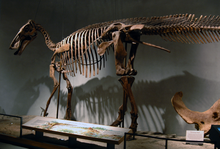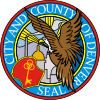Denver Museum of Nature and Science: Difference between revisions
| Line 67: | Line 67: | ||
==Research and Collections== |
==Research and Collections== |
||
'''[http://www.dmns.org/science/collections/anthropology-collections/ Anthropology Collections]''' More than 50,000 objects constitute the Anthropology Collection. As recently described in the book Crossroads of Culture, the collection is mainly comprised of archaeological and ethnological artifacts from North America. The department also curates collections from Central and South America, Africa, Asia, and Oceania. Additional holdings include the 800-piece Ethnological Art Collection and archival photographs and documents. The department is fully committed to compliance with the 1990 Native American Graves Protection and Repatriation Act (NAGPRA) and all other national and international laws that impact anthropological objects. |
|||
'''Anthropology Collections''' |
|||
'''Earth Sciences Collections''' The Department of Earth Sciences collections consist of 6 main groups, including Vertebrate Paleontology, Paleobotany, Invertebrate Paleontology, Mineral, Meteorite, and Micromount. |
'''Earth Sciences Collections''' The Department of Earth Sciences collections consist of 6 main groups, including Vertebrate Paleontology, Paleobotany, Invertebrate Paleontology, Mineral, Meteorite, and Micromount. |
||
| Line 80: | Line 80: | ||
'''Bailey Library and Archives''' |
'''Bailey Library and Archives''' |
||
==Gates Planetarium == |
==Gates Planetarium == |
||
Revision as of 18:49, 29 July 2016
 | |
 | |
| Established | 1900 [1] |
|---|---|
| Location | Denver, Colorado |
| Type | Natural History, Science |
| President | George Sparks [2] |
| Website | http://www.dmns.org/ |
The Denver Museum of Nature & Science is a municipal natural history and science museum in Denver, Colorado. It is a resource for informal science education in the Rocky Mountain region. A variety of exhibitions, programs, and activities help museum visitors learn about the natural history of Colorado, Earth, and the universe. The 716,000-square-foot (66,519 m2) building houses more than one million objects in its collections including natural history and anthropological materials, as well as archival and library resources.
The Museum is an independent, nonprofit institution with approximately 350 full-time and part-time staff, more than 1,800 volunteers, and a 25-member Board of Trustees. It is accredited by the American Alliance of Museums (AAM)[3] and is a Smithsonian Institution Affiliate.
Education programs
The Museum provides programming in six main areas. The exhibitions, IMAX films, lectures, classes, and programs pertain to one or more of the following core competencies:
More than 300,000 students and teachers visit the Museum with school groups each year. In addition, the Museum has science outreach programs and distance–learning opportunities for families, schools and surrounding communities.[4] The Museum also offers teachers ongoing professional training workshops.
History


Founded in 1900, the Denver Museum of Nature & Science is located in Denver’s City Park and has views of Denver and the Rocky Mountains. The Museum has had three different names since it first opened: The Colorado Museum of Natural History, The Denver Museum of Natural History, and now the Denver Museum of Nature & Science.
The Museum traces its origins back to the efforts of one man, a pioneer naturalist named Edwin Carter who devoted his life to the scientific study of Colorado birds, mammals and fauna. Since 1900, the museum collection has grown from Carter’s collection, housed in a log cabin, to a museum housing more than a million objects in its collections.[1] Another man instrumental in developing the museum's collection through the mid 20th century was Dr Alfred Marshall Bailey, who served as Director from 1936 to 1969.
The Museum is known for its children’s discovery areas, the Space Odyssey exhibition, Gates Planetarium, the Prehistoric Journey exhibition, IMAX films, Egyptian mummies, wildlife exhibits, colorful gems and minerals, Expedition Health exhibition, temporary exhibitions, and education programs. Visitors can also experience the “best view in Denver” from the Anschutz Family Sky Terrace and Leprino Family Atrium on the west side of the building. Here, visitors see views of the Front Range, from Longs Peak in the north to Pikes Peak in the south.
The museum is partially funded by the Scientific and Cultural Facilities District (SCFD), which was created by area voters in 1988.[5]
Permanent exhibits

Discovery Zone is a hands-on educational center geared toward children. Dig up a stegosaurus, make fun crafts, play on the discovery stage, inspect insect specimens, and laugh yourself out loud with funhouse mirrors [6]
Egyptian Mummies uses two mummies and their tomb artifacts to teach how the ancient civilization of Egypt regarded its living and preserved its dead.[7]
Expedition Health teaches visitors about the constantly changing and adapting human body.[8]
Gems & Minerals is a re-created mine where visitors can examine many colorful crystals and minerals found both locally and globally.[9]
North American Indian Cultures explores the diversity among Native American groups and the practicality and artistry of their everyday objects.[10]
Prehistoric Journey traces the evolution of life on Earth from single-celled organisms to dinosaurs to the inhabitants of today’s world, with speicmens including the majectic skeleton of diplodocus with a ferocious allosaurus battling a heavy armored stegosaurus, marvel at a beautiful sea lilie reef diorama from 435 million years ago, insect a cast/replica skull of the ancient placoderm fish dunkelosteus, look at a neat collection of trilobites on display for hours, notice every detail of prehistoric mammal skulls [11]
Space Odyssey is about the Universe and our place in it.[12]
Wildlife Exhibits are animal dioramas showing scenes of daily life of many different animals.[13]
Research and Collections
Anthropology Collections More than 50,000 objects constitute the Anthropology Collection. As recently described in the book Crossroads of Culture, the collection is mainly comprised of archaeological and ethnological artifacts from North America. The department also curates collections from Central and South America, Africa, Asia, and Oceania. Additional holdings include the 800-piece Ethnological Art Collection and archival photographs and documents. The department is fully committed to compliance with the 1990 Native American Graves Protection and Repatriation Act (NAGPRA) and all other national and international laws that impact anthropological objects.
Earth Sciences Collections The Department of Earth Sciences collections consist of 6 main groups, including Vertebrate Paleontology, Paleobotany, Invertebrate Paleontology, Mineral, Meteorite, and Micromount.
Education Collections
Health Sciences Collections
Space Sciences Lab
Zoology Collections
Bailey Library and Archives
Gates Planetarium
Gates Planetarium presents a view of the universe, using technology to tell science stories and help visitors experience the universe. The 125-seat planetarium features unidirectional, semi-reclining stadium seating, 16.4 surround-sound system featuring Ambisonic—a 3-D spatial sound system, and a perforated metal dome, 56 feet in diameter and tilted 25 degrees. The current Gates Planetarium replaces the older, dome-style planetarium.
Phipps IMAX Theater
The Phipps IMAX Theater on the second floor of the museum was built as the Phipps Auditorium in 1940, and was used for lectures, concerts, and films until 1980. Renovated and reopened in 1983 as the Phipps IMAX Theater, it seats 440 people and now shows large-format IMAX films daily.
Morgridge Family Exploration Center and Avenir Collections Facility
The Morgridge Family Exploration Center constitutes three above-ground levels devoted to offering memorable and impactful programs that are rich with content and encourages visitors to have in-depth conversations about science and the natural world. Visitors of all ages engage with science in new ways through Exploration Studios for today’s students, a new temporary exhibition gallery, a lively atrium space, a completely redeveloped Discovery Zone for early learners, and the beautiful outdoor Boettcher Plaza with unique public art.
The Avenir Collections Center totals 63,000 square feet in two underground levels devoted to providing consolidated housing for nearly 1.5 million artifacts and specimens for the first time in Museum history, ensuring they are preserved for the public for generations to come.
Museum secrets
While many have visited the Denver Museum of Nature & Science, few have noticed the hidden surprises camouflaged within the museum's exhibits. Kent Pendleton, one of the museum's diorama painters, was unable to sign his work. In lieu of a signature, Pendleton painted a total of 8 elves in his work hidden throughout the museum. Guests are encouraged to search for the elves with a printable scavenger hunt. [14][15]
Finally, in the IMAX lobby entrance there are several painted pictures hidden on the walls relating to Star Wars.[14][15]
See also
Further reading
- Map of the Denver Museum of Nature & Science, February 2006, Denver Museum of Nature & Science.
References
- ^ a b "Museum History". dmns.org. Denver Museum of Nature and Science. Retrieved 11 August 2010.
- ^ "George Sparks". dmns.org. Denver Museum of Nature and Science. Retrieved 11 August 2010.
- ^ "List of Accredited Museums" (PDF). aam-us.org. American Alliance of Museums. Retrieved 6 April 2013.
- ^ "George Sparks". dmns.org. Denver Museum of Nature and Science. Retrieved 11 August 2010.
- ^ "SCFD and the Museum". dmns.org. Denver Museum of Nature and Science. Retrieved 11 August 2010.
- ^ "Discovery Zone". dmns.org. Denver Museum of Nature and Science. Retrieved 11 August 2010.
- ^ "Egyptian Mummies". dmns.org. Denver Museum of Nature and Science. Retrieved 11 August 2010.
- ^ "Expedition Health". dmns.org. Denver Museum of Nature and Science. Retrieved 11 August 2010.
- ^ "Gems & Minerals". dmns.org. Denver Museum of Nature and Science. Retrieved 11 August 2010.
- ^ "North American Indian Cultures". dmns.org. Denver Museum of Nature and Science. Retrieved 11 August 2010.
- ^ "Prehistoric Journey". dmns.org. Denver Museum of Nature and Science. Retrieved 11 August 2010.
- ^ "Space Odyssey". dmns.org. Denver Museum of Nature and Science. Retrieved 11 August 2010.
- ^ "Wildlife Exhibits". dmns.org. Denver Museum of Nature and Science. Retrieved 11 August 2010.
- ^ a b , Elves at Denver Museum of Nature and Science
- ^ a b , Surprises at Denver Museum of Nature and Science PDF description and location of Museum Secrets
External links
- Use dmy dates from June 2011
- Museums in Denver, Colorado
- Institutions accredited by the American Alliance of Museums
- IMAX venues
- Dinosaur museums in the United States
- Natural history museums in Colorado
- Science museums in Colorado
- Egyptological collections in the United States
- Paleontology in Colorado
- Mesoamerican art museums in the United States
- Native American museums in Colorado


